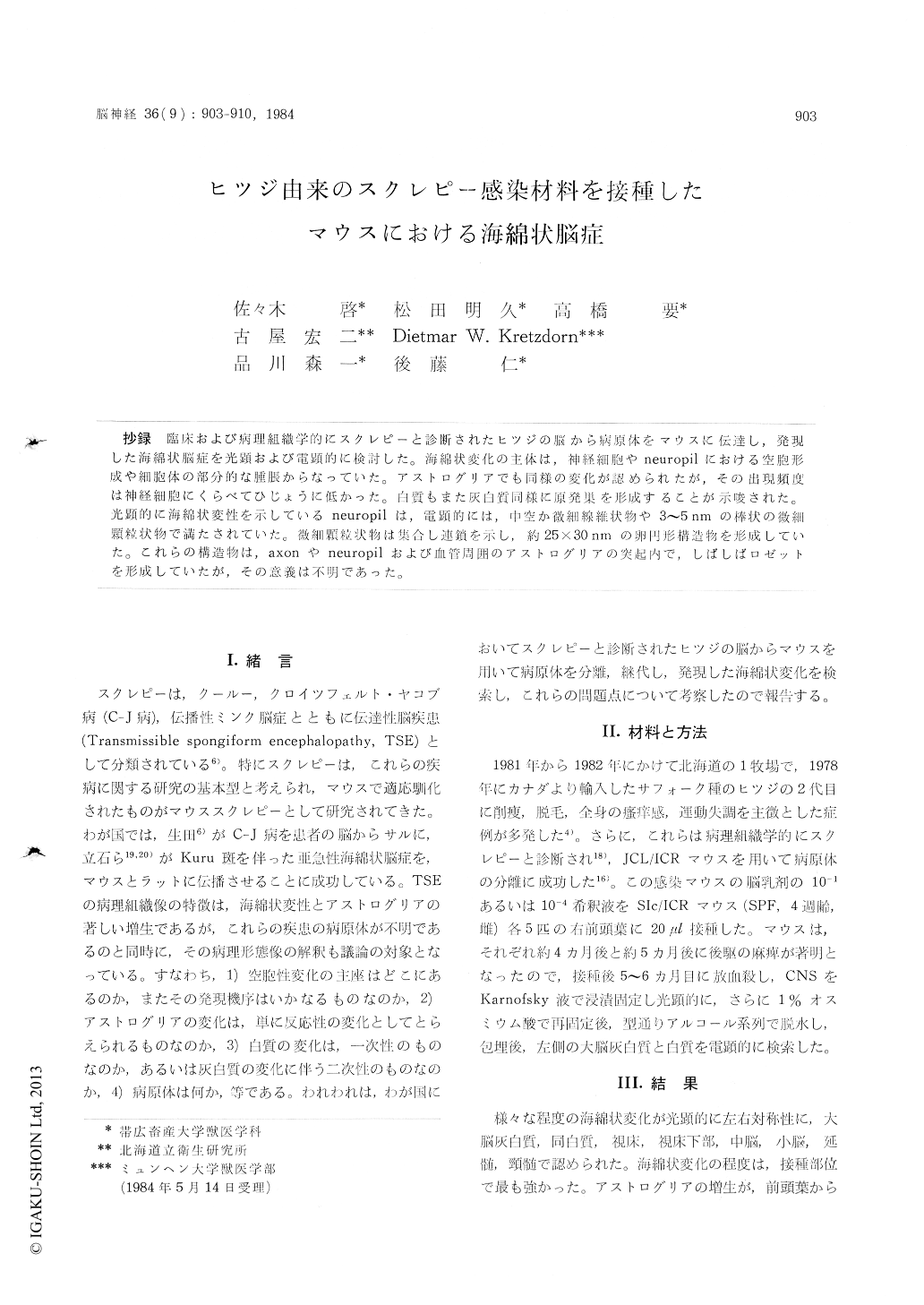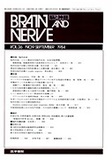Japanese
English
- 有料閲覧
- Abstract 文献概要
- 1ページ目 Look Inside
抄録 臨床および病理組織学的にスクレピーと診断されたヒッジの脳から病原体をマウスに伝達し,発現した海綿状脳症を光顕および電顕的に検討した。海綿状変化の主体は,神経細胞やneuropilにおける空胞形成や細胞体の部分的な腫脹からなっていた。アストログリアでも同様の変化が認められたが,その出現頻度は神経細胞にくらべてひじょうに低かった。白質もまた灰白質同様に原発巣を形成することが示唆された。光顕的に海綿状変性を示しているneuropilは,電顕的には,中空か微細線維状物や3〜5nmの棒状の微細顆粒状物で満たされていた。微細顆粒状物は集合し連鎖を示し,約25×30nmの卵円形構造物を形成していた。これらの構造物は,axonやneuropilおよび血管周囲のアストログリアの突起内で,しばしばロゼットを形成していたが,その意義は不明であった。
The authors report spongy degeneration in ex-perimental scrapie (second passage) in mice. The scrapie agent was originally isolated from Suffolk sheep imported from Canada and diagnosed his-topathologically to be infected with scrapie by intracerebral inoculation into JCL/ICR mice. Ten female SIc/ICR mice, 4 weeks of age, were injec-ted intracerebrally in the right frontal lobus with 20 ul of 10-1 or 10-4 dilution of JCR/ICR mice brain homogenate involving scrapie agent. All animals showed signs of the advanced stages of the disease, clinically manifested by lassitude, arched backs, lethargy and paresis of hind quarters. They were sacrificed five to six months post in-oculation, and sections of the brain and spinal cord were examined by light and electron micro-scopy.
Focal symmetrical spongiform lesions were seen light microscopically in the cerebral mantle, tha-lamus, hypothalamus, midbrain, medulla oblongata, cerebellum and cervical mark. There was evidence that these lesions tended to be more intense in the mice inoculated a higher concentration of scrapie agent. Astrocytic proliferation was present in the deep layer of cerebral gray matter, white matter, corpus callosum, dorsal part of hyppocam-pus and thalamus. No leukocytic infiltration was observed.
Electron microscopically, the spongiform lesions were shown to be caused by vacuolation or swell-ing within the neuropil, and vacuolation and focal swelling in the neuronal perikaryon. The changes in the neuronal perikaryon were caused by en-largement of endoplasmic reticulum and cisterns of the Golgi apparatus, accompanied by spherical swelling of a part of the cytoplasm. The vacuola-tion near or within the neuron produced deforma-tion of the cell contours and displacement of the nucleus. These findings suggest the existence of a storage material in the vacuole, dissolved by some organic solvents during the preparation. In astrocytes there were similar changes as in the neuronal perikaryon. However, the frequency of affected neurons was an overwhelming majority compared with that of affected astrocytes. This may be attributed to the stage of the disease. Confluence of adjacent swollen processes of neu-ropil was observed. Vacuolar space formed by the separation of the intraperiod line of the myelinsheath seemed to fuse with neighboring vacuolar changes of the neuropil. Vacuolar enlargement of axon with thinned myelin sheath in several myelinated nerve fibers was found in seclusion. Narrowed and deformed capillary lumens with pronounced swelling of perivascular astrocytic process were observed. The latter change may contribute to the focal circulatory arrest causing secondary disfunction of brain tissue. Increased pinocytotic vesicles were conspicuous in blood ves-sel walls of venule and arteriole.
Fine, rod-shaped granulas of varying numbers were observed within the swollen axon, neuropil and perivascular astrocytic process. The granulas, which could also be found on the membrane of vacuoles, were 3 to 5 nm in diameter with high and low electron densities. Fine filamentous ma-terials were seen within the spherical swelling of the neuronal perikaryon. The latter seemed to be the degenerated substances of cytoplasmic organ-elles. The most striking finding in this study was the formation of about 25 x 30 nm sized ovoid-shaped structures in the axon, neuropil and peri-vascular astrocytic processes, which were built by aggregation of the above mentioned granulas. These structures seemed to form a rosette and were larger than ribosomes. It is obscure whether they are ribosomes or they play a significant role in relation to the disease.

Copyright © 1984, Igaku-Shoin Ltd. All rights reserved.


